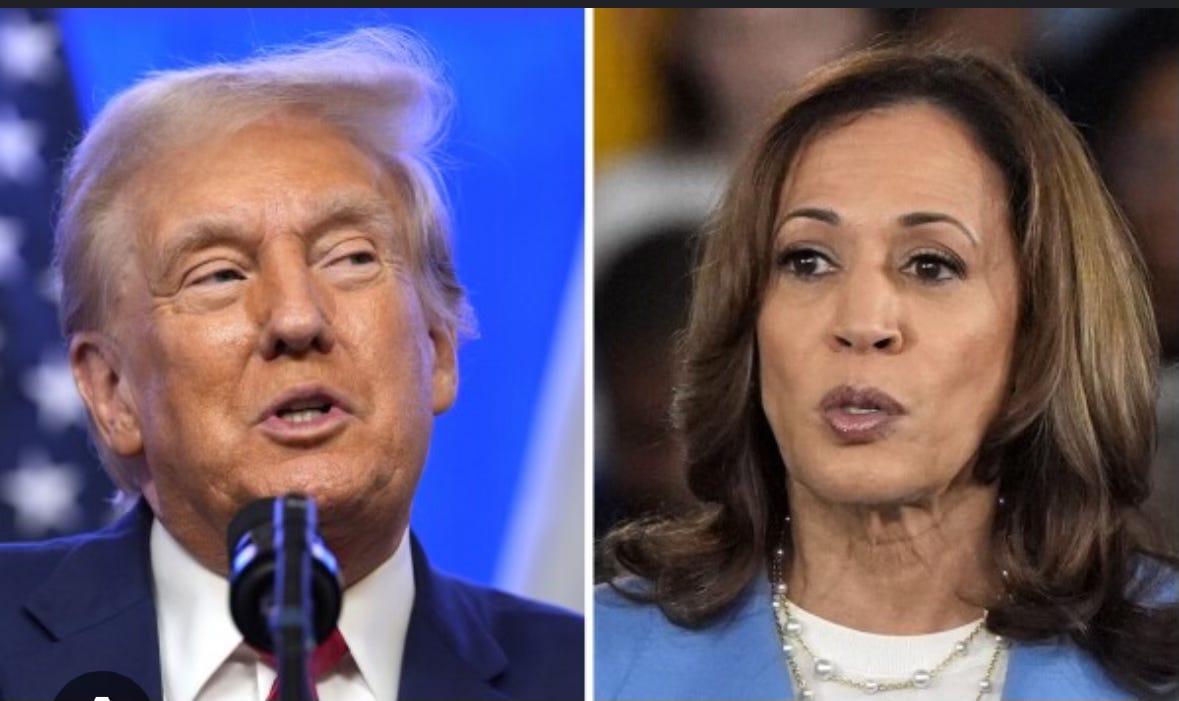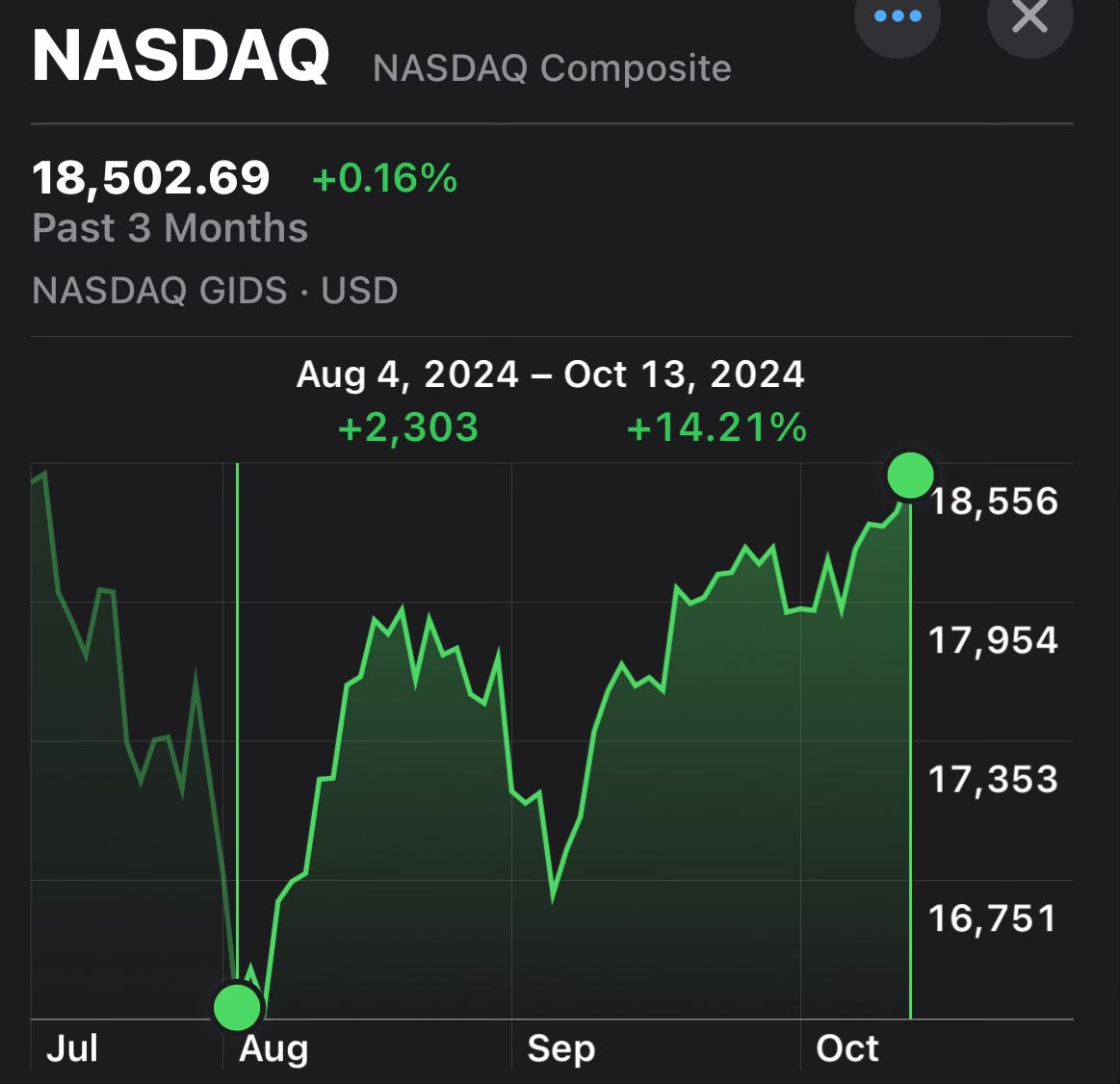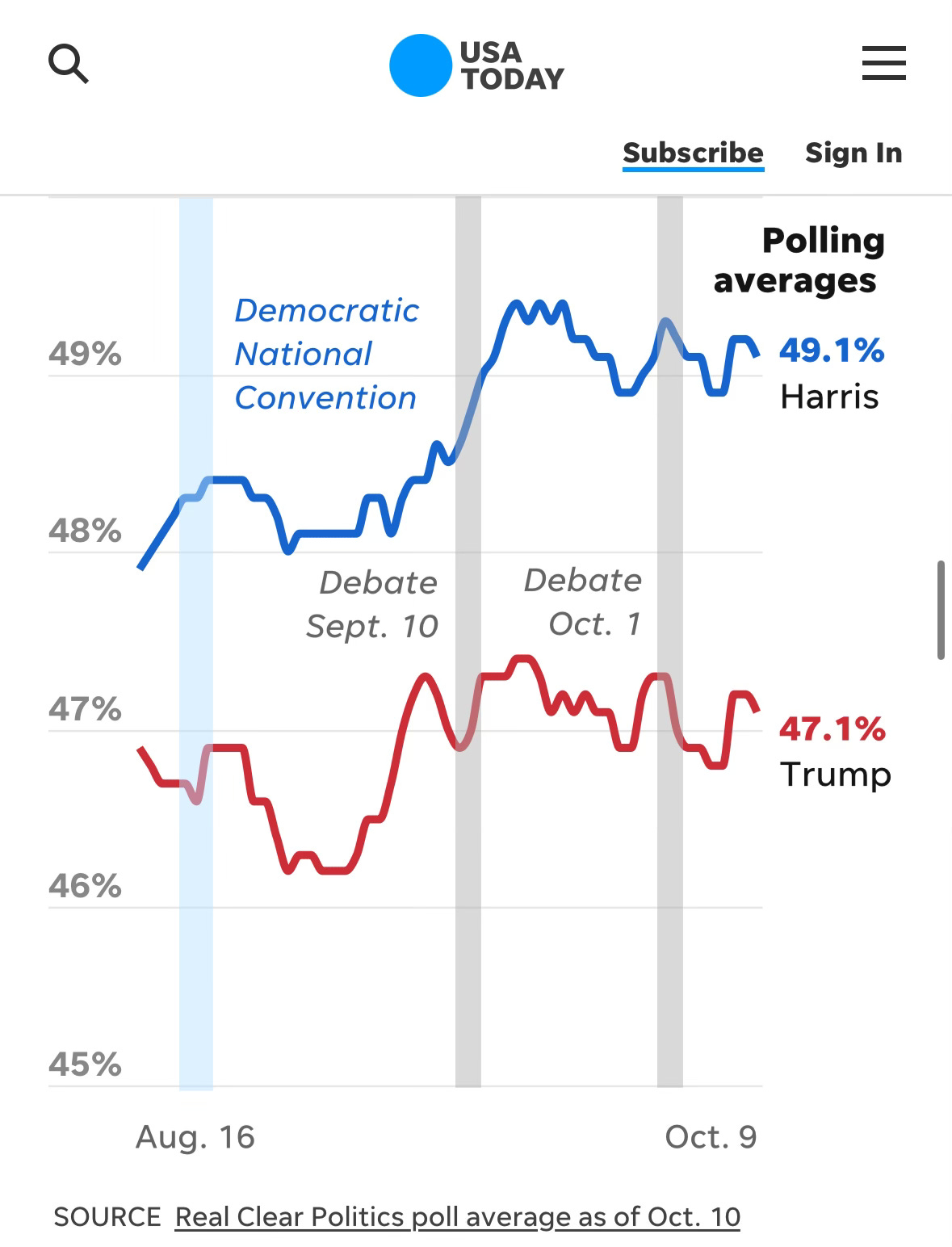Election Odds & Market Signals: Trump vs. Harris
As Trump gains in betting markets, Wall Street bets on a Harris victory—what will the next leader mean for inflation?
In the lead-up to the November 2024 election, financial markets have been sending mixed signals, reflecting the high-stakes environment of this contentious race. While the stock market, bond yields, and gold prices each offer clues about how Wall Street and investors are assessing the potential outcomes, these movements are often nuanced and don’t necessarily align with the broader public’s political betting odds.
First, let’s address the stock market. The U.S. equity markets, particularly the tech-heavy AI Nasdaq, are experiencing one of the most speculative manias in history. The market cap to GDP ratio is currently at an eye-popping 200%, a figure we’ve never seen before, even during previous market bubbles like 1929, 1987, 2000, or 2008. The Shiller price-to-earnings ratio (PE) hovers around 35x, while the broader market’s PE ratio is around 25x, which historically correlates with market tops. Add to that the proliferation of zero-days-to-expiry (ODTE) options, where investors bet on daily price action, and we have a recipe for heightened volatility and fragility. For more on this check out these articles:
As the election race progressed, the stock market peaked at the start of July, shortly after Trump dominated the debate with Biden, causing Biden’s polling numbers to plummet causing him to drop out. Then with no clear opponent against Trump the likeliness of him winning shot up. Then Trump unveiled more details of his economic platform. His promises to reinstate tariffs—potentially up to 200% on Chinese goods—caused fear of another trade war under his administration, reminiscent of 2018 when escalating tariffs led the Nasdaq to plummet -25%. This fear was quickly reflected in stock prices, with the Nasdaq falling -15% between early July to August 4.
This reaction highlights Wall Street’s concerns about Trump’s trade policy. His aggressive stance on tariffs raises fears of reduced global trade, slower economic growth, and corporate profit margin compression. A second-term Trump presidency, with no re-election to worry about, could mean an even more aggressive stance on tariffs, something that businesses and markets alike seem wary of.
However, after Kamala Harris was officially named the Democratic nominee on August 5, markets stopped their free fall. Polling began to show Harris gaining ground, which coincided with a rally in the stock market (as seen above). Harris, who leans more toward the status quo, was perceived as the candidate less likely to upend the current economic framework. As her polling shot up and the stock market followed higher as shown below.
Her platform, however, wasn’t without controversy. On August 26, she proposed $5 trillion in new taxes, including raising the corporate tax rate from 21% to 28% and increasing individual taxes. This, in turn, sparked another selloff, as investors braced for the potential negative impact on corporate earnings and consumer spending. But after Harris softened her stance on certain tax policies distancing her policy from Biden, the markets stabilized again.
From this series of events, it’s clear that the stock market is signaling a preference for Harris over Trump, not because of enthusiasm for her policies, but because Trump’s proposals—especially the tariffs—pose greater risks to global trade and market stability. That said, investors remain cautious about Harris’s potential tax hikes, which could stifle corporate investment and slow economic growth.
Turning to the bond market, the picture is somewhat different. Bond investors have been more responsive to the possibility of a Trump victory. After Trump’s post-debate surge, interest rates fell, with the 10-year U.S. Treasury yield dropping from 4.45% to 3.6%. This decline suggests that investors believed Trump’s policies would be more effective at controlling inflation and reducing the deficit. His proposal to enlist Elon Musk in deficit reduction efforts and reduce the national debt resonated with bondholders who are focused on long-term fiscal sustainability.
However, when Harris started to gain momentum in the polls in September, bond yields reversed course, climbing back to 4.2%. This reflects bond investors’ concerns about her proposed increase in government spending. Harris’s platform includes significant new social programs, such as student loan forgiveness and business debt forgiveness, all without clear mechanisms to control the deficit. With the national debt already ballooning to nearly $36 trillion and annual deficits running at $2 trillion, bond investors fear that more spending without sufficient revenue could reignite inflation, devaluing their holdings and pushing yields even higher.
Speaking of inflation, this issue looms large over the election and the markets. Inflation has already eroded Americans’ purchasing power by -21% over the last three and a half years, with the average inflation rate hovering around -7% a year. Under a Harris administration, which supports more government spending without clear deficit controls, inflation could remain high. This would continue to hurt middle- and lower-income Americans, who bear the brunt of rising prices for essentials like food, housing, and energy. Inflation of this magnitude also risks pushing the Federal Reserve into another round of aggressive rate hikes, which would further stifle economic growth and increase the risk of a recession.
Finally, we turn to gold—the ultimate safe-haven asset. Gold has been on a tear in 2024, up 30% year-to-date. Both Trump and Harris present scenarios that could be bullish for gold. Trump’s hawkish stance on China and geopolitical tensions could lead to greater global instability, driving investors toward safe assets ( which it did in 2018-2020). Harris, on the other hand, with her plans for increased government spending and potentially higher inflation, could push gold prices even higher (as it has under Biden). Gold’s recent stability suggests that investors are waiting for more clarity on the election, but it remains a crucial indicator of broader market sentiment around inflation, debt, and geopolitical risk.
The last item worth paying close attention to is the Las Vegas betting markets on the 2024 election. Interestingly, the trends in betting markets have closely followed the fluctuations in financial markets throughout the race. Initially, when Joe Biden was still in the race, betting odds were roughly 50/50 between him and Donald Trump. After Biden dropped out, Trump’s chances began to surge, with betting markets heavily favoring him. However, once Kamala Harris officially stepped in as the Democratic candidate, and more stable policy information emerged, her odds improved drastically, bringing her neck and neck with Trump, who had previously held a commanding lead.
But in a significant shift over the past week, with just three weeks left until Election Day, the betting odds have swung back in Trump’s favor. As of October 14, 2024, betting markets are giving Trump a 54% chance of winning, with the odds standing at 1.17 in his favor. This shift is remarkable considering that for much of the race, Trump and Harris were nearly even in the betting odds. What makes this divergence particularly intriguing is that financial markets seem to be pricing in a Harris victory, as reflected in the latest data, which suggests Wall Street believes a Harris administration is more likely. Furthermore, most polls still show the candidates in a dead heat, within a margin of error of 3 points.
So, why are the betting odds now tilting in Trump’s favor despite other indicators suggesting a tight race? One plausible explanation is that Trump’s momentum in key swing states has been accelerating. His policies, particularly his focus on combating inflation, are resonating with voters who feel the economic pinch. Trump’s proposals, such as cutting taxes on tips and Social Security, as well as taking a hardline stance in the Rust Belt states, particularly with the auto industry, are gaining traction. These policies are seen as more directly addressing the inflationary pressures that have eroded Americans’ purchasing power over the past three years.
Conversely, Harris’s campaign has stumbled recently. She has been reluctant to engage in interviews, and her campaign videos have been criticized for leaning further left rather than appealing to moderate voters or addressing economic concerns more directly. This lack of engagement and focus may be creating doubt among voters about her ability to combat inflation, the central issue for many Americans in this election. With inflation having drained 21% of the average American’s purchasing power in the past three years, it’s no surprise that voters are gravitating toward a candidate who they believe has a clearer plan to address this crisis.
Now that we’ve examined both the financial markets and betting odds, it’s clear that while Wall Street may be betting on a Harris victory, the public’s sentiment, as reflected in the betting markets, suggests that Trump could very well pull off a win.
If the stock market sells off into the election, along with interest rates falling, betting odds favoring Trump is the signal that would be signaling.
As we approach the conclusion of this election cycle, it’s crucial to understand the broader economic ramifications of either candidate’s victory. Should Harris win, her proposed tax increases and expanded social programs could exacerbate the national debt and keep inflation stubbornly high. This would likely prompt the Federal Reserve to continue its tightening cycle, leading to higher interest rates, which could stifle growth and trigger a recession. In contrast, while Trump’s anti-China trade policies raise concerns about global market stability, his tax-cutting measures and promises to reduce the national debt might be more appealing to investors seeking relief from inflation.
Ultimately, inflation remains the most pressing economic issue in this election, and the policies implemented by the next administration will determine whether the U.S. can rein in rising prices or fall into an inflationary spiral. Americans should be aware that without sound economic strategies, inflation will continue to erode their purchasing power, disrupt financial markets, and increase the risk of long-term economic instability. The stakes could not be higher, and both Wall Street and Main Street will be watching closely as November 2024 approaches.
In conclusion, while stock markets appear to favor Harris for her more predictable policies, bond markets and gold investors are signaling deeper concerns about fiscal sustainability and inflation under either candidate. Inflation remains the wild card, and with it already at dangerously high levels, the next president’s approach to economic policy will be critical in determining whether the U.S. can avoid an inflationary spiral that could devastate the economy for years to come.
For more on inflation check out these articles:
Keep reading with a 7-day free trial
Subscribe to The Coastal Journal to keep reading this post and get 7 days of free access to the full post archives.










